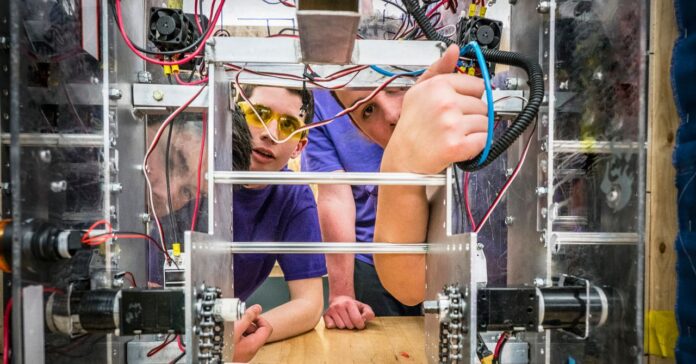In the early 2010s, nearly every STEM-savvy college-bound kid heard the same advice: Learn to code. Python was the new Latin. Computer science was the ticket to a stable, well-paid, future-proof life.
But in 2025, the glow has dimmed. “Learn to code” now sounds a little like “learn shorthand.” Teenagers still want jobs in tech, but they no longer see a single path to get there. AI seems poised to snatch up coding jobs, and there aren’t a plethora of AP classes in vibe coding. Their teachers are scrambling to keep up.
“There’s a move from taking as much computer science as you can to now trying to get in as many statistics courses” as possible, says Benjamin Rubenstein, an assistant principal at New York’s Manhattan Village Academy. Rubenstein has spent 20 years in New York City classrooms, long enough to watch the “STEM pipeline” morph into a network of branching paths instead of one straight line. For his students, studying stats feels more practical.
Forty years ago, students inspired by NASA dreamed of becoming physicists or engineers. Twenty years after that, the allure of jobs at Google or other tech giants sent them into computer science. Now, their ambitions are shaped by AI, leading them away from the stuff AI can do (coding) and toward the stuff it still struggles with. As the number of kids seeking computer science degrees falters, STEM-minded high schoolers are looking at fields that blend computing with analysis, interpretation, and data.
Rubenstein still requires every student to take computer science before graduation, “so they can understand what’s going on behind the scenes.” But his school’s math department now pairs data literacy with purpose: an Applied Mathematics class where students analyze New York Police Department data to propose policy changes, and an Ethnomathematics course linking math to culture and identity. “We don’t want math to feel disconnected from real life,” he says.
It’s a small but telling shift—one that, Rubenstein says, isn’t happening in isolation. After a long boom, universities are seeing the computer-science surge cool. The number of computer science, computer engineering, and information degrees awarded in the 2023–2024 academic year in the US and Canada fell by about 5.5 percent from the previous year, according to a survey by the nonprofit Computing Research Association.
At the high school level, the appetite for data is visible. AP Statistics logged 264,262 exam registrations in 2024, making it one of the most-requested AP tests, per Education Week. AP computer-science exams still draw big numbers—175,261 students took AP Computer Science Principles, and 98,136 took AP Computer Science A in 2024—but the signal is clear: Data literacy now sits alongside coding, not beneath it.
“Students who see themselves as STEM people will pursue whatever they think makes them a commodity, something valued in the workplace,” Rubenstein says. “The workplace can basically shift education if it wants to by saying, ‘Here’s what we need from students.’ K–12 will follow suit.”
Amid all this, AI’s rise leaves teachers in a difficult position. They’re trying to prepare students for a future defined by machine learning while managing how easily those same tools can short-circuit the learning process.
Yet Rubenstein believes AI could become a genuine ally for STEM educators, not a replacement. He imagines classrooms where algorithms help teachers identify which students grasp a concept and which need more time, or suggest data projects aligned with a student’s interests—ways to make learning more individualized and applied.
It’s part of the same shift he’s seen in his students: a move toward learning how to interpret and use technology, not just build it. Other educators are starting to think along similar lines, exploring how AI tools might strengthen data literacy or expand access to personalized STEM instruction.
At the University of Georgia, science education researcher Xiaoming Zhai is already testing what that could look like. His team builds what he calls “multi-agent classroom systems,” AI assistants that interact with teachers and students to model the process of scientific inquiry.
Zhai’s projects test a new kind of literacy: not just how to use AI but how to think with it. He tells the story of a visiting scholar who had never written a line of code yet used generative AI to build a functioning science simulation.
“The bar for coding has been lowered,” he says. “The real skill now is integrating AI with your own discipline.”
Zhai believes AI shouldn’t be treated as an amalgamation of STEM disciplines but as part of its core. The next generation of scientists, he says, will use algorithms the way their predecessors used microscopes—to detect patterns, test ideas, and push the boundaries of what can be known. Coding is no longer the frontier; the real skill is learning how to interpret and collaborate with machine intelligence. As chair of a national committee on AI in science education, Zhai is pushing to make that shift explicit, urging schools to teach students to harness AI’s precision while staying alert to its blind spots.
“AI can do some work humans can’t,” he says, “but it also fails spectacularly outside its training data. We don’t want students who think AI can do everything or who fear it completely. We want them to use it responsibly.”
That balance between fluency and skepticism, ambition and identity, is quietly rewriting what STEM means in schools like Rubenstein’s. Computer-science classes aren’t going away, but they’re sharing the stage with forensics electives, science-fiction labs and data-ethics debates.
“Students can’t think of things as compartmentalized anymore,” Rubenstein says. “You need multiple disciplines to make good decisions.”
AI isn’t coming—it’s here. Today’s STEM students aren’t fighting it; they’re learning to read it, question it, and use it. The new skill isn’t coding the machine, but understanding its logic well enough to steer it.
Disclaimer : This story is auto aggregated by a computer programme and has not been created or edited by DOWNTHENEWS. Publisher: wired.com






